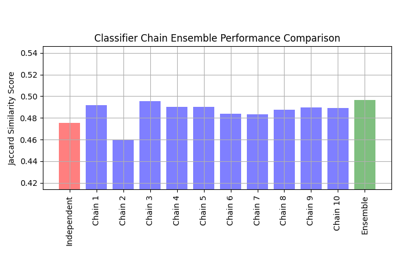sklearn.metrics.jaccard_score#
- sklearn.metrics.jaccard_score(y_true, y_pred, *, labels=None, pos_label=1, average='binary', sample_weight=None, zero_division='warn')[source]#
Jaccard similarity coefficient score.
The Jaccard index [1], or Jaccard similarity coefficient, defined as the size of the intersection divided by the size of the union of two label sets, is used to compare set of predicted labels for a sample to the corresponding set of labels in
y_true.Support beyond term:
binarytargets is achieved by treating multiclass and multilabel data as a collection of binary problems, one for each label. For the binary case, settingaverage='binary'will return the Jaccard similarity coefficient forpos_label. Ifaverageis not'binary',pos_labelis ignored and scores for both classes are computed, then averaged or both returned (whenaverage=None). Similarly, for multiclass and multilabel targets, scores for alllabelsare either returned or averaged depending on theaverageparameter. Uselabelsspecify the set of labels to calculate the score for.Read more in the User Guide.
- Parameters:
- y_true1d array-like, or label indicator array / sparse matrix
Ground truth (correct) labels.
- y_pred1d array-like, or label indicator array / sparse matrix
Predicted labels, as returned by a classifier.
- labelsarray-like of shape (n_classes,), default=None
The set of labels to include when
average != 'binary', and their order ifaverage is None. Labels present in the data can be excluded, for example in multiclass classification to exclude a “negative class”. Labels not present in the data can be included and will be “assigned” 0 samples. For multilabel targets, labels are column indices. By default, all labels iny_trueandy_predare used in sorted order.- pos_labelint, float, bool or str, default=1
The class to report if
average='binary'and the data is binary, otherwise this parameter is ignored. For multiclass or multilabel targets, setlabels=[pos_label]andaverage != 'binary'to report metrics for one label only.- average{‘micro’, ‘macro’, ‘samples’, ‘weighted’, ‘binary’} or None, default=’binary’
If
None, the scores for each class are returned. Otherwise, this determines the type of averaging performed on the data:'binary':Only report results for the class specified by
pos_label. This is applicable only if targets (y_{true,pred}) are binary.'micro':Calculate metrics globally by counting the total true positives, false negatives and false positives.
'macro':Calculate metrics for each label, and find their unweighted mean. This does not take label imbalance into account.
'weighted':Calculate metrics for each label, and find their average, weighted by support (the number of true instances for each label). This alters ‘macro’ to account for label imbalance.
'samples':Calculate metrics for each instance, and find their average (only meaningful for multilabel classification).
- sample_weightarray-like of shape (n_samples,), default=None
Sample weights.
- zero_division“warn”, {0.0, 1.0}, default=”warn”
Sets the value to return when there is a zero division, i.e. when there there are no negative values in predictions and labels. If set to “warn”, this acts like 0, but a warning is also raised.
- Returns:
- scorefloat or ndarray of shape (n_unique_labels,), dtype=np.float64
The Jaccard score. When
averageis notNone, a single scalar is returned.
See also
accuracy_scoreFunction for calculating the accuracy score.
f1_scoreFunction for calculating the F1 score.
multilabel_confusion_matrixFunction for computing a confusion matrix for each class or sample.
Notes
jaccard_scoremay be a poor metric if there are no positives for some samples or classes. Jaccard is undefined if there are no true or predicted labels, and our implementation will return a score of 0 with a warning.References
Examples
>>> import numpy as np >>> from sklearn.metrics import jaccard_score >>> y_true = np.array([[0, 1, 1], ... [1, 1, 0]]) >>> y_pred = np.array([[1, 1, 1], ... [1, 0, 0]])
In the binary case:
>>> jaccard_score(y_true[0], y_pred[0]) 0.6666...
In the 2D comparison case (e.g. image similarity):
>>> jaccard_score(y_true, y_pred, average="micro") 0.6
In the multilabel case:
>>> jaccard_score(y_true, y_pred, average='samples') 0.5833... >>> jaccard_score(y_true, y_pred, average='macro') 0.6666... >>> jaccard_score(y_true, y_pred, average=None) array([0.5, 0.5, 1. ])
In the multiclass case:
>>> y_pred = [0, 2, 1, 2] >>> y_true = [0, 1, 2, 2] >>> jaccard_score(y_true, y_pred, average=None) array([1. , 0. , 0.33...])
Examples using sklearn.metrics.jaccard_score#

Multilabel classification using a classifier chain
